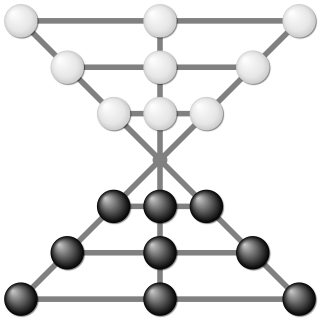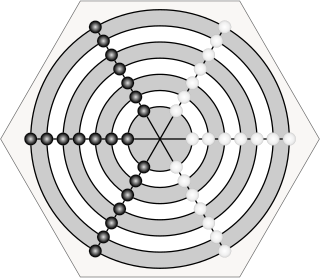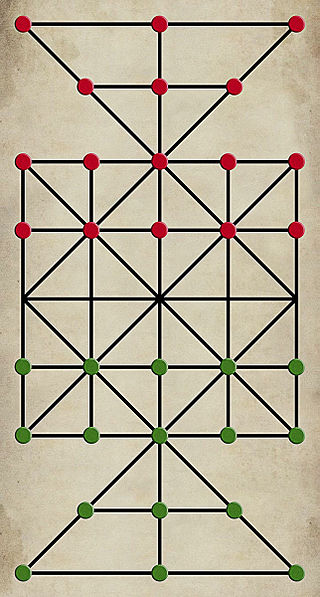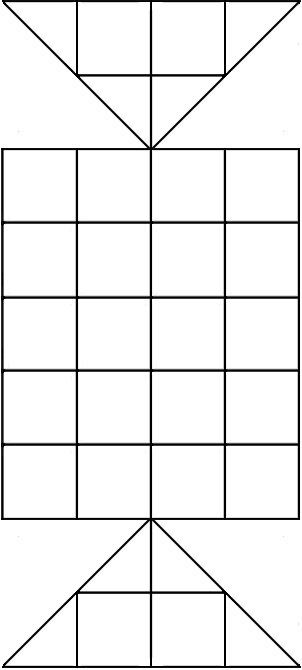Permainan-Tabal is an Indonesian two-player abstract strategy board game. The game is sometimes referred to as a cross between alquerque and draughts. It is essentially draughts played on an expanded alquerque board. It is especially similar to draughts in that the moves of the pieces are strictly forward and sideways until they are promoted to kings by reaching the other player's first rank. The game is also referred to as dama.
Kolowis Awithlaknannai is a two-player strategy board game from the Zuni Native American Indians. It was described by Stewart Culin in his book Games of the North American Indians (1907), and may have been the first publication of the game. It was later described in R.C. Bell's book Board and Table Games from Many Civilizations (1969). R.C. Bell coined the term fighting serpents, but provides no explanation for it. Perhaps the black and white pieces are laid out in the beginning of the game in such a way that it looks like two serpents fighting.

Lau kata kati is a two-player abstract strategy game from India, specifically from Lower Bengal, and also from United Provinces, Karwi Subdivision where it is called Kowwu Dunki, and it was described by H.J.R. Murray in A History of Board-Games Other Than Chess (1952). The game is related to draughts and even more so to Alquerque. Pieces are captured by leaping over them. The board is a pattern of two triangles joined together at a common vertex with further lines subdividing them. It is the same game as Butterfly (game) from Mozambique, which suggests a historical connection between the two games. Lau kata kati belongs to a specific category of games called Indian War-games, and the other games in this category are Dash-guti, Egara-guti, Pretwa, Gol-skuish. All Indian War-games have one important thing in common, and that is that all the pieces are laid out on the patterned board, with only one vacant point in the center. This forces the first move to be played on the central point, and captured by the other player's piece.
Dash-guti is a two-player abstract strategy board game from India, specifically from Central Provinces, United Provinces, Karwi Subdivision where it is called Kowwu Dunki which is the same name given to another similar game called Lau kata kati, and it was described by H.J.R. Murray in A History of Board-Games Other Than Chess (1952). The game is related to Draughts and even more so to Alquerque. Pieces are captured by leaping over them. Dash-guti consists of a Lau kata kati board, but with the addition of two line segments connected to the vertex but exterior to both triangles. Dash-guti belongs to a specific category of games called Indian War-games, and the other games in this category are Lau kata kati, Egara-guti, Pretwa, Gol-skuish. All Indian War-games have one important thing in common, and that is that all the pieces are laid out on the grid patterned board, with only one vacant point in the centre. This forces the first move to be played on the central point, and captured by the other player's piece.
Egara-guti is a two-player abstract strategy game from India, specifically from Central Provinces, and it was described by H.J.R. Murray in A History of Board-Games Other Than Chess (1952). The game is related to Draughts and even more so to Alquerque. Pieces are captured by leaping over them. Egara-Guti consists of a Lau kata kati board, but with the addition of two lines connecting the two triangles and running through them. Egara-guti belongs to a specific category of games called Indian War-games; some other games in this category are Lau kata kati, Dash-guti, Pretwa, Gol-skuish. All Indian War-games have one important thing in common, and that is that all the pieces are laid out on the grid patterned board in the beginning, with only one vacant point in the center. This forces the first move to be played on the central point, and captured by the other player's piece.

Pretwa is a two-player abstract strategy game from Bihar, India, and it was described by H.J.R. Murray in A History of Board-Games Other Than Chess (1952). The game is related to draughts and Alquerque as pieces are captured by leaping over them. The board is composed of three concentric circles divided by three diameters. Pretwa belongs to a category of games called Indian war games, which also includes the games Lau kata kati, Dash-guti, Egara-guti, Gol-skuish. All Indian war games have one important thing in common, and that is that all the pieces are laid out on the board at every intersection point, with the exception of the central point. This forces the first move to be played on the central point, and captured by the other player's piece.

Gol-skuish is a two-player abstract strategy game from India, specifically from Central Provinces, and it was described by H.J.R. Murray in A History of Board-Games Other Than Chess (1952). The game belongs to the draughts and Alquerque family as pieces are captured by leaping over them. The board is composed of seven concentric circles divided by three diameters. Gol-skuish belongs to a specific category of games called Indian War-games which include Lau kata kati, Dash-guti, Egara-guti, and Pretwa. At the beginning of every Indian War-game all the pieces are laid out on the board at every intersection point, with the exception of the central point. This forces the first move of the game to be played on the central point, and captured by the second player's piece.

Peralikatuma is a two-player abstract strategy board game from Sri Lanka. It is a game related to draughts (checkers) and alquerque as players hop over one another's pieces when capturing them. The game was documented by Henry Parker in Ancient Ceylon: An Account of the Aborigines and of Part of the Early Civilisation (1909) with the name perali kotuwa or the war enclosure. Parker mentions that it is also played in India. It closely resembles another game from Sri Lanka called Kotu Ellima. The two games use the same board which consist of a standard alquerque board but with four triangular boards attach to its four sides. The only difference between the two games is in the number of pieces. In peralikatuma, each player has 23 pieces. In Kotu Ellima, each player has 24 pieces.
Catch the hare is a two-player abstract strategy board game from Europe, and perhaps specifically from Spain. It is a hunt game, and since it uses a standard alquerque board from the game alquerque de doze, it is specifically a tiger hunt game. In some variants, some or all of the diagonal lines are missing which makes it difficult to classify as a tiger game in general. One hare is going up against ten to twelve opponents(hunters or hounds). The hare is the "tiger" in this hunt game which is prey and predator at the same time. The hare can capture the opponents by leaping over them. The opponents attempt to surround and trap the hare.
Zamma is a two-player abstract strategy game from Africa. It is especially played in Mauritania. The game is similar to alquerque and draughts. Board sizes vary, but they are square boards, such as 5x5 or 9x9 square grids with left and right diagonal lines running through several intersection points of the board. One could think of the 5x5 board as a standard alquerque board, but with additional diagonal lines, and the 9x9 board as four standard alquerque boards combined, but no additional diagonal lines are added. The initial setup is also similar to alquerque, where every space on the board is filled with each player's pieces except for the middle point of the board. Furthermore, each player's pieces are also set up on their respective half of the board. The game specifically resembles draughts in that pieces must move in the forward directions until they are crowned "Mullah" which is the equivalent of the king in draughts. The Edhayam can move in any direction. In Mauritania, the black pieces are referred to as men, and the white pieces as women. In the Sahara, short sticks represent the men, and camel dung represent the women.

Kharbaga is a two-player abstract strategy game from North Africa. In a way, it is a miniature version of Zamma; however, there are more diagonal lines per square on the board as compared to Zamma. The game is considered part of the Zamma family. The game is also similar to Alquerque and draughts. The board is essentially an Alquerque board with twice the number of diagonal lines or segments allowing for greater freedom of movement. The initial setup is also similar to Alquerque, where every space on the board is filled with each player's pieces except for the middle point of the board. Moreover, each player's pieces are also set up on each player's half of the board. The game specifically resembles draughts in that pieces must move in the forward directions until they are crowned "Mullah" which is the equivalent of the King in draughts. The Mullah can move in any direction.
Tiger game played with forty, translation of meurimueng-rimueng peuet ploh, is a two-player abstract strategy board game from Sumatra, Indonesia. The last part of the name, ploh, is sometimes spelled "plo". It is specifically played by the Acehnese. The game was described in The Achehnese by Hurgronje, O'Sullivan, and Wilkinson in 1906 and described on page 204.
Fetaix is a two-player abstract strategy board game from Morocco. It is very similar to Alquerque. The only difference is that pieces cannot move backwards until they are promoted to Mullah which is the equivalent of King in draughts. Furthermore, Mullahs can move any number of vacant points on the board, and capture enemy pieces from any distance similar to the Kings in International draughts. Another name for the game is qireq.

Sixteen soldiers is a two-player abstract strategy board game from Sri Lanka. It also comes from India under the name cows and leopards. A variant of this game is also popular in Bangladesh, where it is known as sholo guti. One way it is played, is by drawing the court of the game on the ground and using stones as pawns.
Kotu Ellima is a two-player abstract strategy board game from Sri Lanka played by the Sinhalese people. The game was documented by Henry Parker in Ancient Ceylon: An Account of the Aborigines and of Part of the Early Civilisation (1909); the game was printed as "Kotu Ellima" which is actually a misspelling because his source for the game was Leopold Ludovici's Journal of the Ceylon Branch of the Royal Asiatic Society (1873), and specifically in the chapter entitled "The Sports and Games of the Singhalese", and Ludovici wrote the name of the game as Kotu Ellime or Taking of the Castles. The game is similar to draughts (checkers) and Alquerque as players hop over one another's pieces to capture them; it is more similar to Alquerque between the two since it uses a standard Alquerque board. However, unlike draughts and standard Alquerque, the game is played on an expanded Alquerque board consisting of four triangular boards attached to the four sides of a standard Alquerque board. It closely resembles peralikatuma and sixteen soldiers which are also played in Sri Lanka and other parts of the Indian subcontinent with the only difference being the number of pieces. In sixteen soldiers, each player has 16 pieces hence the name of the game. In peralikatuma, each player has 23 pieces. In Kotu Ellima, each player has 24 pieces, and at the beginning of the game the whole board is covered with them except the central point reminiscent of standard alquerque.
Tûkvnanawöpi is a two-player abstract strategy board game played by the Hopi native American Indians of Arizona, United States. The game was traditionally played on a slab of stone, and the board pattern etched on it. Tukvnanawopi resembles draughts and Alquerque. Each player attempts to capture each other's pieces by hopping over them. It is unknown how old the game is; however, the game was published as early as 1907 in Stewart Culin's book "Games of the North American Indians Volume 2: Games of Skill".
Awithlaknannai Mosona is a two-player strategy board game from the Zuni Native American Indian tribe of New Mexico, United States. It is unknown how old the game is. The game was described by Stewart Culin in his book "Games of the North American Indians Volume 2: Games of Skill" (1907). In this book, it was named Awithlaknan Mosona. Awithlaknannai Mosona resembles another Zuni board game called Kolowis Awithlaknannai with few minor differences. The former having a smaller board, and depending upon the variant, it also has less lines joining the intersection points. The rules are the same. Awithlaknannai Mosona belongs to the draughts and alquerque family of games as pieces hop over one another when capturing. It is actually more related to Alquerque, since the board is made up of intersection points and lines connecting them. It is thought that the Spanish had brought Alquerque to the American Southwest, and Awithlaknannai Mosona may have been an evolution from Alquerque. However, in Stewart Culin's 1907 book, the Zunis claim that they had adopted a hunt game from Mexico similar to catch the hare and the fox games of Europe, and transformed it into Awithlaknannai Mosona. In these games, one player has more pieces over the other, however, the other player's piece has more powers. The Zuni's equalized the numbers of pieces and their powers, and also may have transformed the board making its length far exceed its width. Diagonal lines also replaced orthogonal lines altogether. However, the hunt game from Mexico may have used an alquerque board even though the game mechanics of their new game, Awithlaknannai Mosona, were completely different.
Indian and jackrabbits is a two-player abstract strategy board game from the Tiwa tribe of Taos, New Mexico. A similar game with a slightly different board is also played by the Tohono O'odham tribe of Arizona. From the outset, these games look like hunt games similar to catch the hare, the fox games of Europe, and the tiger and leopard games of Asia, because they use very similar boards, and the game mechanics are the same, and the number of pieces each player controls is different. However, they are not the same games, because the goals are completely different. The goal of the one Indian is to capture just one of the twelve jackrabbits. The goal of the jackrabbits is to move themselves safely onto the other side of the board mirroring their initial positions.
Sua ghin gnua is a two-player abstract strategy board game from Thailand, formerly known as Siam. Another name for the game is tigers and oxen. It is a hunt game played on a 5x5 square grid with only orthogonal lines. One player plays the three tigers, and the other player plays the twelve oxen. The board is empty in the beginning. Players first drop their pieces onto the board, and then are able to move them. The tigers can capture the oxen by the short leap as in draughts and alquerque, but the oxen attempt to elude and at the same time hem in the tiger. Sua Ghin Gnua most resembles the tiger hunt games such as bagh-chal, rimau-rimau, main tapal empat, catch the hare, and adugo since they all use a 5 x 5 square grid. But tiger games technically consist of a standard alquerque board which is a 5 x 5 square grid with several diagonal lines criss-crossing through it which are completely missing in sua ghin gnua. There are however some variants of catch the hare which have missing diagonal lines also. Another game that resembles sua ghin gnua is from Myanmar, called tiger and buffaloes, which is a hunt game consisting of a 4 x 4 square grid with no diagonal lines. Myanmar happens to border Thailand geographically so there might be a historical connection between the two games. Another game from Myanmar is lay gwet kyah that is presumed to be similar to sua ghin gnua. Sua ghin gnua was briefly described by Stewart Culin, in his book Chess and Playing Cards: Catalogue of Games and Implements for Divination Exhibited by the United States National Museum in Connection with the Department of Archaeology and Paleontology of the University of Pennsylvania at the Cotton States and International Exposition, Atlanta, Georgia 1895 (1898). It's also briefly mentioned by H.J.R. Murray in his book A History of Chess (1913). It was also described by R.C. Bell, in his book Board and Table Games from Many Civilizations (1969).

Astar is a two-player abstract strategy board game from Kyrgyzstan. It is a game similar to draughts and Alquerque as players hop over one another's pieces when capturing. However, unlike draughts and Alquerqe, Astar is played on 5×6 square grid with two triangular boards attached on two opposite sides of the grid. The board somewhat resembles those of kotu ellima, sixteen soldiers, and peralikatuma, all of which are games related to astar. However, these three games use an expanded alquerque board with a 5×5 square grid with diagonal lines. Astar uses a 5×6 grid with no diagonal lines.







